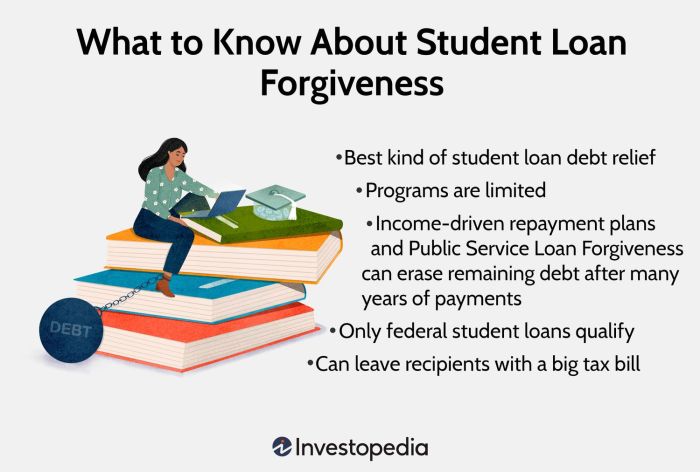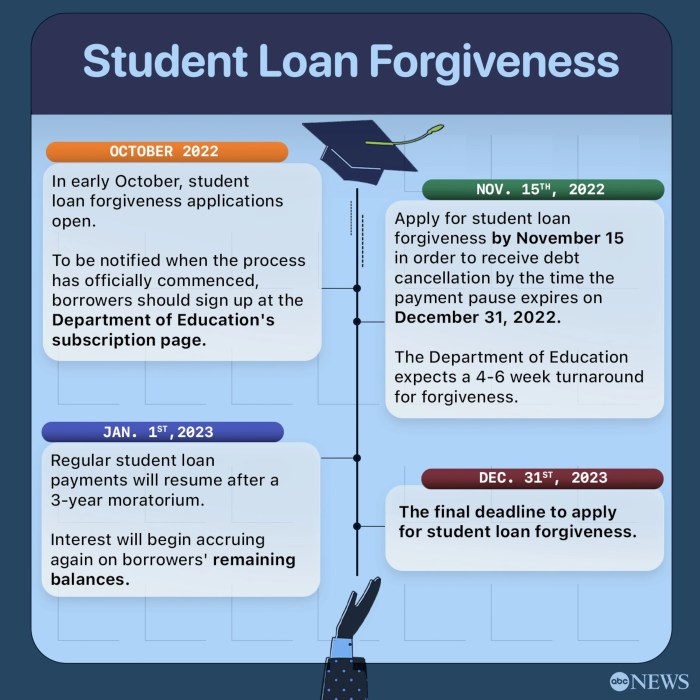
The question, “Were my student loans forgiven?” weighs heavily on the minds of millions grappling with student loan debt. Navigating the complex landscape of federal loan forgiveness programs can feel overwhelming, with various eligibility requirements, application processes, and potential pitfalls. This guide provides a clear and concise overview of the available options, focusing on the Public Service Loan Forgiveness (PSLF) program and exploring alternative pathways to debt relief.
From understanding the intricacies of income-driven repayment plans to deciphering the tax implications of loan forgiveness, we aim to demystify the process and empower you to make informed decisions about your financial future. We’ll explore common challenges, offer practical advice for a successful application, and equip you with the knowledge to confidently pursue loan forgiveness.
Understanding the PSLF Program

The Public Service Loan Forgiveness (PSLF) program is a federal initiative designed to incentivize individuals pursuing careers in public service by offering loan forgiveness after 120 qualifying monthly payments. It’s a valuable tool for those dedicated to public service, but understanding its eligibility criteria and application process is crucial for successful participation.
PSLF Eligibility Requirements
To be eligible for PSLF, borrowers must meet several key requirements. They must have received a Direct Loan (or consolidated their Federal Family Education Loan (FFEL) Program loans into a Direct Consolidation Loan) and be employed by a qualifying employer. This employment must be full-time, and the borrower must be making qualifying monthly payments under an income-driven repayment plan. The type of income-driven repayment plan is crucial; only payments made under an approved plan (such as ICR, PAYE, REPAYE, orIBR) count towards the 120 payment requirement. Finally, the borrower must have made 120 qualifying payments while working full-time for a qualifying employer.
Steps Involved in Applying for PSLF
The application process for PSLF involves several key steps. First, borrowers must consolidate their federal student loans into a Direct Consolidation Loan if they haven’t already. This is necessary to ensure all loans are eligible for the program. Next, borrowers need to complete and submit the PSLF form, which requires documentation verifying their employment and loan details. Regularly monitoring the progress of the application through the official website is crucial, and borrowers should anticipate processing times and potential requests for additional information. It is strongly recommended to submit the PSLF form annually to track progress and ensure payments are accurately counted. Careful documentation of employment and repayment history is vital for a successful application.
Examples of Qualifying Employment Under PSLF
Qualifying employment under PSLF encompasses a broad range of public service roles. This includes government jobs at the federal, state, or local level. Examples include working as a teacher in a public school, a social worker for a government agency, or a law enforcement officer. Additionally, employment with a non-profit organization that provides public services, such as a charity providing healthcare or education, may also qualify. The key determinant is whether the employer is a 501(c)(3) non-profit organization and the work directly serves the public interest. It’s important to note that self-employment generally does not qualify unless it directly involves providing public service.
Comparison of PSLF with Other Loan Forgiveness Programs
| Program | Loan Type | Employment Requirements | Payment Requirements |
|---|---|---|---|
| PSLF | Direct Loans | Full-time public service employment | 120 qualifying payments under an income-driven repayment plan |
| Teacher Loan Forgiveness | Federal Stafford, Subsidized and Unsubsidized | Full-time employment as a teacher in a low-income school | 5 years of qualifying service |
| Public Service Loan Forgiveness (PSLF) | Direct Loans (or consolidated FFEL loans) | Full-time employment for a qualifying public service employer | 120 qualifying monthly payments under an income-driven repayment plan |
| Income-Driven Repayment (IDR) Plans | Various Federal Student Loans | No specific employment requirements | Payments based on income; remaining balance forgiven after 20-25 years |
Navigating the Application Process
The Public Service Loan Forgiveness (PSLF) program, while offering significant debt relief, presents a complex application process. Understanding the common pitfalls and employing strategic preparation significantly increases your chances of successful forgiveness. This section Artikels key aspects of navigating the application, focusing on reasons for denials and strategies for a smooth submission.
Common Reasons for PSLF Application Denials
Many PSLF applications are denied due to seemingly minor oversights. These often stem from a lack of understanding of program requirements or insufficient documentation. Careful attention to detail throughout your repayment period and during the application itself is crucial. The most frequent causes of denial include incorrect employment certification, missing payment counts, and failure to consolidate loans into the Direct Loan program before applying. Even seemingly small discrepancies can lead to rejection. For instance, a slight variation in employer name or a missing date on a certification form can invalidate the entire application.
Tips for Successfully Navigating the PSLF Application Process
Proactive planning and meticulous record-keeping are vital for a successful PSLF application. Begin by thoroughly reviewing your loan servicer’s statements to ensure all payments are accurately recorded. Maintain copies of all employment certifications, payment confirmations, and any communication with your loan servicer. Consider using a dedicated folder or spreadsheet to organize all your documentation. Regularly check your PSLF tracker to monitor your progress and identify any potential issues early on. Furthermore, seeking guidance from a financial advisor or student loan counselor can prove invaluable in navigating the complexities of the program. They can offer personalized advice and help you avoid common mistakes.
Step-by-Step Guide for Submitting a PSLF Application
The PSLF application process involves several key steps. First, consolidate your federal student loans into a Direct Consolidation Loan if you haven’t already. Next, complete and submit the PSLF Employment Certification Form, ensuring accurate completion of all fields and obtaining the necessary employer signature. This form requires detailed information about your employment history, including dates of employment and job titles. Third, submit your application through the official PSLF website, providing all required documentation. Regularly monitor your application status online and address any requests for additional information promptly. Finally, maintain open communication with your loan servicer throughout the process.
Importance of Accurate Documentation in the Application
Accurate documentation is paramount for a successful PSLF application. Any inaccuracies or inconsistencies can lead to delays or denial. This includes providing precise dates of employment, accurate job titles, and matching information across all submitted forms. Each piece of documentation plays a crucial role in verifying your eligibility. For example, an incorrectly filled Employment Certification Form might lead to a rejection even if all your payments are correctly recorded. Therefore, double-check all information before submission, ensuring consistency and accuracy throughout the entire process. Remember, a single error can have significant consequences.
Impact of Income-Driven Repayment Plans

Income-driven repayment (IDR) plans are crucial for borrowers aiming for Public Service Loan Forgiveness (PSLF). These plans tie your monthly payments to your income and family size, making them more manageable than standard repayment plans. Understanding how IDRs interact with PSLF is essential for maximizing your chances of loan forgiveness.
IDR plans and PSLF are intrinsically linked because PSLF requires 120 qualifying monthly payments under an eligible repayment plan. Most IDR plans qualify, but it’s vital to ensure your payments are correctly certified as qualifying. Misunderstandings or errors in this process can significantly delay or even prevent loan forgiveness.
Income-Driven Repayment Plan Comparisons
Several IDR plans exist, each with its own nuances. Choosing the right plan depends on individual financial circumstances and long-term goals. Key differences lie in how income and family size are factored into monthly payment calculations, and the length of the repayment period.
| Plan Name | Payment Calculation | Repayment Period | Forgiveness Provisions |
|---|---|---|---|
| Income-Based Repayment (IBR) | Based on discretionary income and family size; payment may be $0. | 25 years (undergrad loans) / 25 or 30 years (Grad PLUS loans) | Remaining balance forgiven after the repayment period. |
| Pay As You Earn (PAYE) | 10% of discretionary income; payment may be $0. | 20 years | Remaining balance forgiven after the repayment period. |
| Revised Pay As You Earn (REPAYE) | 10% of discretionary income for undergraduate loans, 10% or 15% for graduate loans; payment may be $0. | 20 or 25 years | Remaining balance forgiven after the repayment period. |
| Income-Contingent Repayment (ICR) | 20% of discretionary income for undergraduate loans, 25% for graduate loans. | 25 years | Remaining balance forgiven after the repayment period. |
Potential Pitfalls of Income-Driven Repayment Plans
While IDR plans offer significant advantages, several potential pitfalls exist. These can significantly impact your path to PSLF.
Firstly, payments may be significantly lower than under standard repayment plans, resulting in a longer repayment period. This extends the time it takes to reach the 120 qualifying payments required for PSLF. Secondly, income certification is required annually, requiring borrowers to actively update their income and family size information. Failure to do so can result in incorrect payment calculations and delays in the PSLF process. Finally, the exact amount of loan forgiveness will depend on the length of time spent in repayment and the amount of the original loan balance. While the remaining balance is forgiven after the repayment period, this doesn’t mean that the total amount paid is insignificant. It’s crucial to understand these aspects before selecting an IDR plan.
Impact of IDR Plans on Loan Forgiveness Timelines
The primary impact of IDR plans on PSLF timelines is the extension of the repayment period. Because payments are lower, it takes longer to reach the 120 qualifying payments. For example, a borrower with a $50,000 loan under a standard 10-year repayment plan might make significantly higher monthly payments compared to the same loan under an IDR plan. This could mean reaching the 120 payment threshold much sooner under the standard plan. However, the significantly lower monthly payments of the IDR plan may be more manageable financially in the short term. The ultimate choice depends on the borrower’s individual financial situation and risk tolerance. Careful planning and consistent monitoring are vital to successfully navigate this process and achieve PSLF.
Exploring Alternative Loan Forgiveness Options

While the Public Service Loan Forgiveness (PSLF) program is a significant avenue for student loan forgiveness, several other options exist for borrowers meeting specific criteria. Understanding these alternatives is crucial for individuals seeking debt relief, as eligibility requirements and forgiveness amounts vary considerably. This section explores some key alternatives.
Teacher Loan Forgiveness
Teacher Loan Forgiveness offers partial loan forgiveness to eligible teachers who have completed five years of full-time teaching in low-income schools or educational service agencies. To qualify, teachers must have received a Direct Subsidized Loan, Direct Unsubsidized Loan, Stafford Loan, or Federal Consolidation Loan. They must also meet specific requirements regarding the type of school and the number of hours taught. Forgiveness is applied to the principal balance of the loans, up to a maximum of $17,500. The application process involves submitting documentation proving the five years of qualifying service and employment verification from the school or agency.
Loan Forgiveness Through Military Service
Certain military service members may qualify for loan forgiveness or repayment assistance programs. The specifics vary depending on the branch of service and the type of service provided. For example, some programs may offer partial or full loan repayment for those serving in specific roles or locations, while others may provide incentives for individuals who commit to a certain length of service. The Department of Defense and each individual branch offer resources and information regarding their specific loan repayment or forgiveness programs. Eligibility criteria are usually linked to specific military occupations, length of service, and deployment details. Documentation of military service and loan details are necessary for applications.
Other Federal Student Loan Forgiveness Programs
Beyond PSLF, Teacher Loan Forgiveness, and military programs, other niche federal loan forgiveness programs exist. These often target specific professions or circumstances. It’s important to research these programs thoroughly, as eligibility requirements are highly specific. Examples might include programs for nurses or other healthcare professionals working in underserved areas, or forgiveness for those working in public interest law. The specifics of these programs, their eligibility requirements, and application processes should be carefully reviewed on the official government websites. A thorough review of available options is recommended.
Decision-Making Flowchart for Choosing a Loan Forgiveness Option
A flowchart would visually represent the decision-making process. It would start with assessing the borrower’s loan type and employment history. Branches would lead to eligibility checks for PSLF, Teacher Loan Forgiveness, and military loan repayment programs. Each program’s eligibility criteria would be assessed, leading to either an application submission or a path to exploring other options. If none of these programs are suitable, the flowchart would guide the borrower to explore income-driven repayment plans or other debt management strategies. The final outcome would be a chosen path towards loan repayment or forgiveness.
Final Thoughts
Securing student loan forgiveness can be a transformative experience, offering a pathway to financial freedom and stability. While the process can be intricate, understanding the available programs and their requirements is the first step toward success. By carefully considering your eligibility, meticulously preparing your application, and understanding the long-term implications, you can significantly improve your chances of achieving debt relief. Remember, seeking professional financial advice can provide invaluable support throughout this journey.
Commonly Asked Questions
What happens if my PSLF application is denied?
If your application is denied, you’ll receive a notice explaining the reasons. You can appeal the decision, providing additional documentation to address the issues raised. Consider seeking assistance from a student loan expert.
Can I consolidate my loans to qualify for PSLF?
Yes, consolidating your federal student loans into a Direct Consolidation Loan can be beneficial for PSLF eligibility, especially if you have loans not eligible under the Direct Loan program. However, be mindful that consolidation resets your payment count.
How long does the PSLF application process typically take?
Processing times vary, but it’s crucial to submit your application well in advance of your expected 120th qualifying payment. Allow ample time for the Department of Education to review your documentation.
Are there any penalties for receiving student loan forgiveness?
While forgiven amounts are generally not taxed under current law (this could change), it’s important to consult a tax professional to understand the potential implications for your specific situation.
